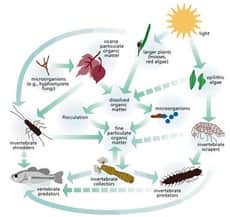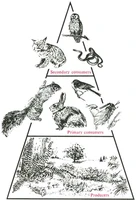Food Web Worksheets

Food web worksheets, energy pyrmaid worksheets, and energy flow lesson plans that are designed for high school, middle school, and elementary school life science teachers. Energy pyramid worksheets include the 10% rule through the trophic levels. Food chain worksheets allow students to see the basics on how energy flows through an ecosystem. Click the Free Lesson Plan (PDF) link below or become a member to get access to the answer key and editable file. Free food web curriculum includes:
-

Food Web Worksheet Free Lesson Plan
High School Worksheet
Students label the plants and animals of a food web and food chains for producer / consumer and either herbivore / carnivore / omnivore. Students then create their own food web using the animals provided.NGSS Standard
HS-LS2-4
MS-LS2-3 (Cycles & Energy Flow)
Published by Shannan Muskopf
-

Energy Pyramid Test Question Bank  Free Lesson Plan (PDF)
Free Lesson Plan (PDF)
Lesson Plan (DOCX) & Answer Key with Membership
High School Test
The energy pyramid quiz question bank includes food webs, food chains, trophic levels, the energy pyramid, and the 10% rule for energy transfer. You can use the question bank to build assessments, and active membership is required to view questions.NGSS Standard
HS-LS2-4
Published by NGSS Life Science
-

Food Webs and Pond Water Lab Free Lesson Plan
Middle School Lab
Students are going to construct a food web, identify aquatic organisms, and determine environmental impacts to aquatic ecosystems.NGSS Standard
HS-LS2-4
MS-LS2-3 (Cycles & Energy Flow)
Published by Tracy Trimpe
-

How Matter & Energy Moves Through The Ecosystem Project  Free Lesson Plan (PDF)
Free Lesson Plan (PDF)
Lesson Plan (DOCX) & Answer Key with Membership
High School Project
In this carbon cycle project, students will model how a carbon atom makes a round trip from a person through the atmosphere and ecosystem and end finally back in the same person. This carbon cycle project video covers concepts like photosynthesis, consumption, cellular respiration, carbon reservoirs, and the 10% rule for energy flow.NGSS Standard
HS-LS1-5
HS-LS1-7
HS-LS2-4
MS-LS2-3 (Cycles & Energy Flow)
Published by NGSS Life Science
-

Build an Food Web Lab Free Lesson Plan
Elementary School Lab
Using biotic and abiotic factors, students will build a food web and energy pyramid using examples of producers, consumers, and decomposers. Craters of the Moon National MonumentNGSS Standard
5-LS2-1 (Movement of Matter)
Published by National Park Service
-

Tracing Energy Through an Ecosystem Free Student Handout
Free Multimedia
Free Lesson Plan
High School Worksheet
In this activity students are reminded of why organisms need to lose carbon atoms: They need to use the chemical energy in organic molecules. All carbon-transforming processes use chemical energy for some cell functions; then lose heat to the environment (this heat is ultimately radiated into outer space). Thus, matter cycles; energy flows in ecosystems.NGSS Standard
HS-LS2-4
MS-LS2-3 (Cycles & Energy Flow)
Published by CarbonTIME
-

Biomass Patterns in Ecosystems Free Student Handout
Free Multimedia
Free Lesson Plan
Middle School Worksheet
Students use the results of the Meadow Simulation to recognize a consistent pattern in ecosystems: the biomass in the herbivore population is smaller than the producer biomass, and biomass in the carnivore population is always the smallest.NGSS Standard
HS-LS2-4
Published by Carbon TIME
-

Food Chain Lab - Owl Pellets Free Student Handout
Middle School Lab
In this food chain lab, students dissect owl pellets to learn how the owl is part of a food chain. Since the owl regurgitates these compact pellets, owl pellets are undigested parts that the owl eats, which contain fur and bones of small rodents. Dry pellets will not smell and are acceptable for students to handle with gloves.NGSS Standard
HS-LS1-2
HS-LS2-4
MS-LS1-7 (Metabolism)
MS-LS2-1 (Resource Availability)
Published by Shannan Muskopf
